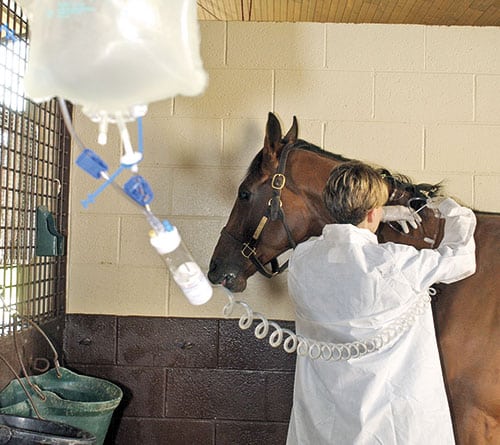Recognizing Klebsiella Pneumonia in Practice

Krista Estell, DVM, Dipl. ACVIM, a staff veterinarian at the university’s School of Veterinary Medicine, presented the results of that study presented the team’s findings at the 2015 American Association of Equine Practitioners’ Convention, held Dec. 5-9 in Las Vegas
In a retrospective study the team examined medical records of 46 horses diagnosed with Klebsiella pneumonia over the course of 20 years. The horses ranged in age from 12 hours to 24 years old, indicating that the bacterium doesn’t discriminate by age. The treating veterinarians confirmed Klebsiella pneumonia using a transtracheal wash (in which the veterinarian flushes sterile saline into the trachea and aspirates and collects the fluid with tubing and a syringe) followed by bacterial culture and isolation, and they treated the horses with intravenous antibiotics, anti-inflammatories, and supportive care (such as fluid, nutritional, and respiratory support therapies), Estell said.
Other key findings included:
- Eleven of the 46 horses had been on a ventilator for breathing assistance before diagnosis, nine horses had partaken in strenuous exercise, and seven had been recently transported;
- Klebsiella pneumoniae was the predominant organism found in 35 of the horses;
- The team found that 47% of the isolates were multidrug resistant; still, they found that the antibiotic amikacin was effective in killing the bacteria;
- The team found lesions in the lungs of both adult horses and foals with ultrasound;
- They weren’t able to identify any specific radiographic patterns suggestive of Klebsiella pneumonia, but they did find that five adult horses had sharp lines of demarcation and severe pulmonary consolidation (fluid and inflammatory cells filling the lung tissue);
- Twenty-five horses developed complications, including laminitis and hemorrhagic (bloody) nasal discharge;
- The overall survival rate was 70%, though Estell noted that foals had higher survival rates than adults;
- Horses that developed laminitis, hemorrhagic nasal discharge, and whose radiographs revealed the line of demarcation were more likely to die than those that did not;
- Researchers completed necropsies on 12 of the 14 horses that died or were euthanized; 11 of the horses had evidence of Klebsiella spp colonization organs besides the lungs; and
- Histopathology (examination of tissue for disease or damage) revealed evidence of thrombosis (blood clotting) in the lungs of eight horses, and evidence of systemic inflammatory response syndrome (or SIRS, a body-wide inflammatory state) in seven.
Ultimately, the team determined that veterinarians should consider pneumonia caused by Klebsiella spp as a differential diagnosis for horses with hemorrhagic nasal discharge. Further, because they observed multidrug resistance in their Klebsiella samples, they urged practitioners to determine which medications the bacteria are sensitive to prior to beginning treatment.
Estell also stressed the importance of adhering to proper biosecurity measures (such as wearing gloves, protective clothing, and boots; treating and/or feeding the affected horse or horses last; and using bleach footbaths) to reduce the potential spread of disease.

Written by:
Erica Larson
Related Articles
Stay on top of the most recent Horse Health news with















